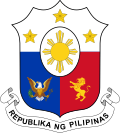| |||||||||||||||||
| |||||||||||||||||
| |||||||||||||||||
 |
|---|
The 1943 Philippine presidential election was held on September 25, 1943, at the midst of World War II.
The Japanese-sponsored Second Philippine Republic merged all parties into the KALIBAPI, thereby creating a one-party state. All of the members of the National Assembly of the Second Philippine Republic, who were elected earlier in the week, were members of the KALIBAPI. Pursuant to the 1943 constitution, Jose P. Laurel was unanimously elected president by the National Assembly. [1] Jorge B. Vargas originally wanted to run against Laurel, but acquiesced on election eve, and consequently campaigned for the latter. The Japanese also wanted Manuel Roxas to run, but he declined due to ill health for being incarcerated earlier in the year.
